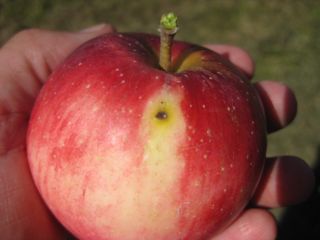Contents
-
Upcoming meetings
The way I see it
- Apple maturity report
- Honeycrisp storage recommendations
- Insect damage puzzle solved?
Upcoming meetings
December 15-17, 2009: New
England Vegetable & Fruit Conference, Manchester, NH
The final program for the New England Vegetable and Fruit Conference has been posted on the Conference website, http://www.newenglandvfc.org. There will be three tree fruit sessions. Please mark you calendar now for this important educational opportunity.
The way I see it
See apple maturity report. The next (and last for 2009) Healthy Fruit will be published on or about September 30, or check my blog for more timely updates on apple maturity. J. Clements
Apple maturity report
General comments on 09/14/09 apple maturity: all fruit tested picked at UMass Orchard, Belchertown. Fruit maturity is moving along rapidly, particularly McIntosh and Honeycrisp. There is less than a week left to pick McIntosh for CA storage. (September 19 to be exact in Belchertown.) Honeycrisp are at their optimum harvest maturity, but will soon start to go by and drop will become excessive unless fruit was treated with ReTain. Honeycrisp fruit should be kept at app. 60 degrees F. for 5-6 days after harvest before being put in cold storage at 38 degrees F. Gala has a bit to go but is adequate for first harvest. Background color change from green to yellow-cream is evident. Let's hope the sugars develop in Gala over the next week. J. Clements
| Cultivar | date | pre-harvest drop |
color % red |
fruit diameter inches |
firmness lbs |
soluble solids |
starch index |
comments |
|---|---|---|---|---|---|---|---|---|
| Snappy Mac McIntosh | 9/14/2009 | few |
95 |
3.3 |
14.6 |
13 |
5.8 (4.5-7) |
scab |
| Rogers Red McIntosh | 9/14/2009 | some |
80 |
3.3 |
13.3 |
11.9 |
5.2 (4-6.5) |
common mid-season Mac |
| Blondee | 9/14/2009 | nil |
10% red blush |
2.9 |
20.1 |
11.2 |
3.9 (3-5) |
an attractive, uniform apple, need another week |
| Brookfield Gala | 9/14/2009 | none |
90 |
2.9 |
19.4 |
11.3 |
4.9 (3-6.5) |
could wait a few more days for first pick, but close (sugars still low) |
| Redmax McIntosh | 9/14/2009 | some |
80 |
3.2 |
14.6 |
12.8 |
6 |
nice Mac strain, distinctly striped |
| Honeycrisp | 9/14/2009 | some |
55 |
3.3 |
13.5 |
11.7 |
6.5 (6-8) |
perfect |
Honeycrisp storage recommendations
Many of you may know it is best to leave Honeycrisp 'out-of-cold-storage' for a period of time directly after harvest to improve storage life and in-particular help prevent the development of soft scald. Here is the specific recommendation for New York Honeycrisp (closest to our conditions) from this web page: http://smfarm.cfans.umn.edu/HoneycrispNewyork.htm
Honeycrisp Storage
"Use delayed cooling of 10-20 °C (50-68 °F) for 1 week prior to long-term storage at 3.5 °C (38 °F). However, this may increase levels of bitter pit (Watkins et al., 2004), senescent breakdown, and rot (Robinson and Watkins, 2003). Warmer storage temperatures will decrease incidence of soggy breakdown, soft scald, and superficial scald.
"Honeycrisp is susceptible to Penicillium blue mold (Rosenberger, 2003). Sanitize bins, packing areas, and storage rooms, and keep fruit away from bins and areas contaminated with blue mold."
References
- Watkins, C., Nock, J., Weis, S., Jayanty, S., Beaudry, R. 2004. Storage temperature, diphenylamine, and prestorage delay effects on soft scald, soggy breakdown and bitter pit of 'Honeycrisp' apples. Postharvest Biol Tech. 32:213-221.
- Robinson, T., Watkins, C. 2003. Cropload of Honeycrisp apple affects not only fruit size but many quality attributes. NY Fruit Quarterly 11.
- Rosenberger, D. 2003. Susceptibility of new apple cultivars to common apple diseases. N.Y. Fruit Quarterly 11(2):17-22. HC Disease suscep-NYFQ-03.pdf
- Rosenberger, D. 2004. Fruit decay problems in Honeycrisp. Proc. New Engl. Fruit and Veg. Conf. Manchester, NH. Dec. 15-16. HC summer decays extn article.pdf
Insect damage puzzle solved?
I had been noticing a lot of this kind of injury (left picture below) to apples at the UMass Orchard in Belchertown while harvesting fruit. Often, it was below where a leaf was in close proximity to the fruit (right picture), so it smacked of leafroller injury, however, I was seeing a lot of stink bugs in the orchard too. And it was not the classic leafroller injury you often find where much more of the surface of the fruit is damaged. I sent a picture of the injury to Art Agnello of Cornell and here is his response:
"This looks to be a 'classic' OBLR feeding sting, which do indeed tend to occur under leaves and between clustered fruits. Looks like you folks have "arrived" into the fraternity of growing regions needing to deal with this perennial favorite."
Now, we have in fact had oblique-banded leafroller (OBLR) in Belchertown over the past few years, and have treated for it somewhat aggressively with insecticides, however, my impression is we have backed off a bit in the last year. So, I am wondering if this kind of injury portends a building population of OBLR and thus we will need to be wary of the potential for a problem in 2010?
J. Clements


